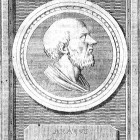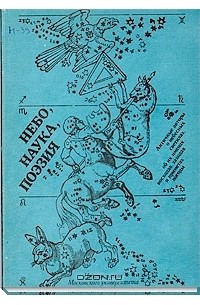
Автор
Лучшие книги Арата Солийского
- 2 произведения
- 5 изданий на 2 языках
По популярности
-
Явления Арат из Сол
ISBN: 5-89329-298-7 Год издания: 2000 Издательство: Алетейя Язык: Русский "Явления" Арата Солийского (ок. 315-240 гг. до н. э.) - важнейший образец "ученой" поэзии эпохи эллинизма. В европейской литературе Арат был первым, кто поэтически целенаправленно и, не будучи ученым, достаточно полно систематизировал астрономические и метеорологические наблюдения своего времени. Дидактические особенности поэмы, нетривиально отразившие научные, поэтические и философские подтексты предшествующей Арату традиции и пристрастия современной ему эпохи, оказали существенное воздействие на литературно-философскую мысль античности и Нового времени. Перевод поэмы Арата на русский язык выполнен с соблюдением метрических особенностей оригинала, снабжен экзегетическим комментарием и вступительной статьей. Издание рассчитано на всех, кто интересуется античной литературой и культурой. -
Небо, наука, поэзия (сборник) Феофраст , Евклид , Арат из Сол , Эратосфен , Леонтий Механик
ISBN: 5-211-00473-6 Год издания: 1992 Издательство: Издательство МГУ Язык: Русский Книга знакомит с астрономическими и метеорологическими представлениями древних греков, отразившимися в их мифологии и литературе. Дана общая картина развития греческой культуры и науки в VI — II вв. до н. э. Особое место отводится памятникам литературы: приведены отрывки из поэм Гомера и Гесиода, впервые публикуются переводы поэмы Арата «Феномены» и ряда других произведений. Приводятся тексты некоторых комментаторов Арата, излагающие различные астрономические теории древности. Все тексты сопровождаются необходимыми историческим, астрономическим и метеорологическим комментариями. Книга иллюстрирована гравюрами XVI в., изображающими созвездия, и рисунками с античных ваз. Для широкого круга читателей, интересующихся античной мифологией и историей науки. -
Constellation Myths: with Aratus's Phaenomena Aratus, Hyginus, Eratosthenes
ISBN: 9780198716983 Год издания: 2015 Издательство: Oxford University Press Язык: Английский 'Athena seized the writhing serpent and hurled it into the sky, and fixed it to the very pole of the heavens.'
The constellations we recognize today were first mapped by the ancient Greeks, who arranged the stars into patterns for that purpose. In the third century BC Eratosthenes compiled a handbook of astral mythology in which the constellations were associated with figures from legend, and myths were provided to explain how each person, creature, or object came to be placed in the sky. Thus we can see Heracles killing the Dragon, and Perseus slaying the sea-monster to save Andromeda; Orion chases the seven maidens transformed by Zeus into the Pleiades, and Aries, the golden ram, is identified flying up to the heavens.
This translation brings together the later summaries from Eratosthenes' lost handbook with a guide to astronomy compiled by Hyginus, librarian to Augustus. Together with Aratus's astronomical poem the Phaenomena, these texts provide a complete collection of Greek astral myths; imaginative and picturesque, they also offer an intriguing insight into ancient science and culture. -
Aratus: Phaenomena (Cambridge Classical Texts and Commentaries) Арат из Сол
ISBN: 0521607124 Год издания: 2004 Язык: Английский Book DescriptionAratus of Soli was a highly original poet of the early third century BC, famous throughout antiquity for his poem on constellations and weather signs, and imitated by later Greek and Latin poets. This volume presents for the first time inEnglish an edition of the poem with a full introduction, a facing translation and a line-by-line commentary. The text is based on a new reading of the manuscripts, including one not used before. The work provides a valuable basis for further research on Aratus and on Hellenistic poetry in general. -
Hymns and Epigrams. Lycophron: Alexandra. Aratus: Phaenomena Каллимах из Кирены, Ликофрон , Арат из Сол
ISBN: 978-0674991439 Издательство: Harvard University Press Язык: Английский Callimachus of Cyrene, 3rd century BCE, became after 284 a teacher of grammar and poetry at Alexandria. He was made a librarian in the new library there and prepared a catalogue of its books. He died about the year 240. Of his large published output, only 6 hymns, 63 epigrams, and fragments survive (the fragments are in Loeb no. 421). The hymns are very learned and artificial in style; the epigrams are good (they are also in the Loeb Greek Anthology volumes).
Lycophron of Chalcis in Euboea was a contemporary of Callimachus in Alexandria where he became supervisor of the comedies included in the new library. He wrote a treatise on these and composed tragedies and other poetry. We possess Alexandra or Cassandra wherein Cassandra foretells the fortune of Troy and the besieging Greeks. This poem is a curiosity―a showpiece of knowledge of obscure stories, names, and words.
Aratus of Soli in Cilicia, ca. 315–245 BCE, was a didactic poet at the court of Antigonus Gonatas of Macedonia, where he wrote his famous astronomical poem Phaenomena (Appearances). He was for a time in the court of Antiochus I of Syria but returned to Macedonia. Phaenomena was highly regarded in antiquity; it was translated into Latin by Cicero, Germanicus Caesar, and Avienus.




